You Bike When It’s 5 Below?!
Here's the best clothing and gear to wear in polar weather. But you might get tired of people asking you about it.
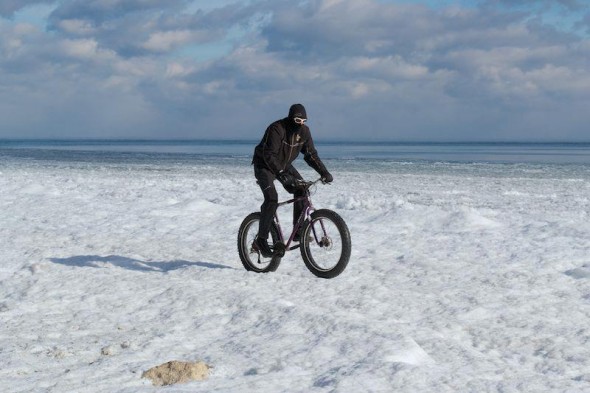
You don’t have to dress like the famous Chris Zito rocking his fatbike on the shores of Lake Michigan at 2 degrees above zero. Photo by Greg Smith of Schlick Cycles
If you are a 365 days-a-year bicyclist, or even a 363 cyclist like my co-worker Jake, you get used to being asked if you biked to work any time the weather gets “bad.” Pouring rain? Expect to get asked if you pedaled to work. Snowing? Expect to get asked. Freezing cold? Expect to get asked.
So I’ve come to understand why people ask. And actually, as temperatures dip below zero with 26 mph winds, there is real value in answering the question of “how did you stay warm biking to work in this arctic weather?” Those sorts of weather conditions, after all, force even some of the most ardent bike commuters into a car if they have one. But I have a system of regular clothes that keeps me warm from my head to my toes and allows me to look reasonably normal.
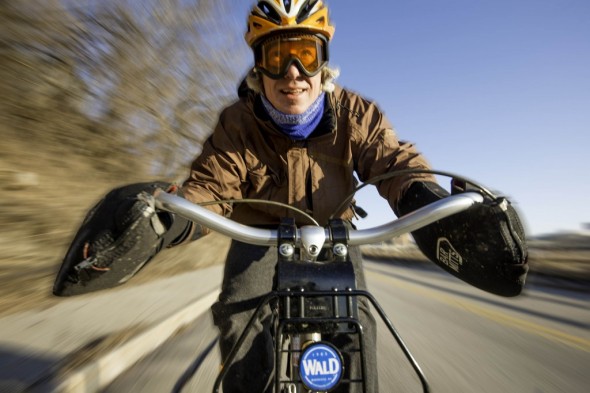
Head treatment: helmet, hat, goggles, turtle
From top to bottom, below is my system to keep myself warm on a bike even on the very coldest sub-zero days without looking like an arctic explorer:
Helmet and hat: I use my regular helmet, but some people use winter helmets that have linings and vents that close. I just put a thin, windproof hat under my regular helmet and open up the straps a little and have never had a problem. One key detail is that I make sure to pull down the front of the hat so it completely covers my forehead right down to the top of my eyebrows.
Goggles: on really cold days with high winds, I wear a cheap pair of ski goggles to keep my eyes from tearing. The goggles have the added bonus of covering a lot of my face that is exposed to the wind and possible frost bite. If you are going out to buy a pair, look for goggles with very light or no tinting as it is often dark during commuting hours. You could also look for goggles with nose covers built-in or the kind that snap on. These are pretty common now. It is pretty easy to find clear Snowmobile or ATV goggles with nose covers.
Turtle or scarf: I find that if I keep my chin and neck covered from the wind, my whole body feels a lot warmer. Turtle fur neck covers are really soft and breathable. You can easily pull them up over your chin, ears, and even your nose if you want. Scarfs work pretty well too, but if they are thick, I sometimes find the knot interferes with full movement of my head to look over my shoulder when changing lanes.
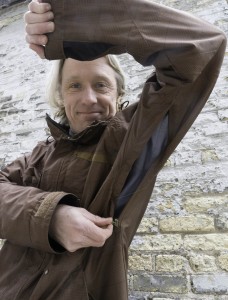
Pit zips are a big plus even on “breathable” waterproof jackets.
Jacket: Like most people who are active outdoors all year round, I have lots of different jackets in different thicknesses, rainproof, vented, breathable, etc. Even when it is really cold, I find I need either vents or a breathable jacket to keep from sweating. Humans generate a lot of heat and moisture when we ride bikes, and unless that perspiration has a place to go, you will feel damp and cold as soon as you stop pedaling. Personally, I am a big fan of pit zips in my waterproof jackets. The bigger the opening the better. It is also nice to be able to grab the zipper with a gloved hand so you can start the ride with the zips closed and open them as you heat up.
One other thing for the boys to remember is the need for your jacket to be long enough to cover your crotch. Unless you want to wear Gore-tex underwear (yes they make it), you need something to block sub-zero winds from freezing your hidden extremities. One of my favorite winter jackets is the London Fog Trench Coat with the lining in. You can find these for $10 at any thrift store. They keep you legs warm too and allow you skip long underwear if your office is hot.
Pants and long underwear: I have a number of wool dress pants from heavy to thinner that I can combine with wool long johns to keep my legs warm. The trick is not wearing something that you are going to sweat in all day in the office. As mentioned above, long trench coats help keep your legs warm and The Bike Fed office is kept around 60 degrees, which makes it easier for me to balance the ride to work with working in the office. I also have a pair of gray Carhartt flannel lined pants that look dressy enough to wear to the office when paired with a button down shirt.
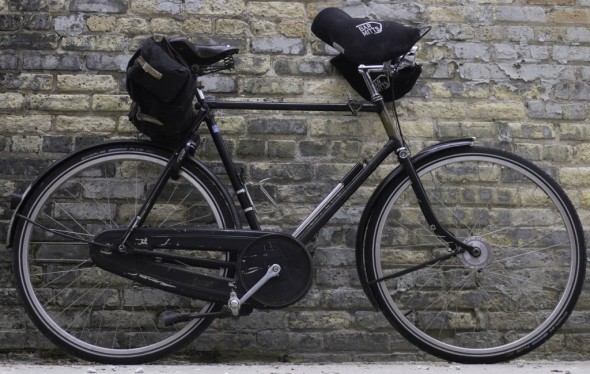
I think the Bar Mitts look rather nice on my black 1936 Raleigh.
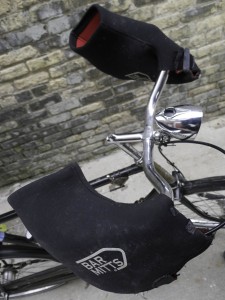
Bar Mitts designed for flat bars fit fine on swept back commuter bars.
Bar Mitts: My fingers start to get uncomfortably cold as soon as the temperatures dip below 40 degrees. When my friends with better circulation than me are out riding in gloves, I am in mittens. When the mercury falls below zero, even heavy mittens don’t keep my fingers warm. Bar Mitts to the rescue!
I got a pair of these “pogies” last year, and they are my new favorite winter riding partners. Made of neoprene, it only takes about 5 minutes to swap these from one bike to another with the zippers and hook and loop fasteners. I use them for mountain biking, fat biking and commuting.
I have the model designed for flat bars, but they work fine on swept back or “priest bars.” I really can’t say enough good things about these. Down to twenty degrees or so, I don’t even wear gloves when I ride with Barr Mitts. Below 20 (even in minus 5) degrees, I slip on a basic pair of gloves. If you have perennially cold fingers, I strongly encourage you to give them a try. Believe me, I have tried all the super heavy duty, very expensive mittens, and Bar Mitts beat them all.
Speaking of cost, while Bar Mitts cost $65, less than many of the warmest pairs of mittens, if you are on a super tight budget, you can find online videos about how to make DIY pogies out of old kids jackets.
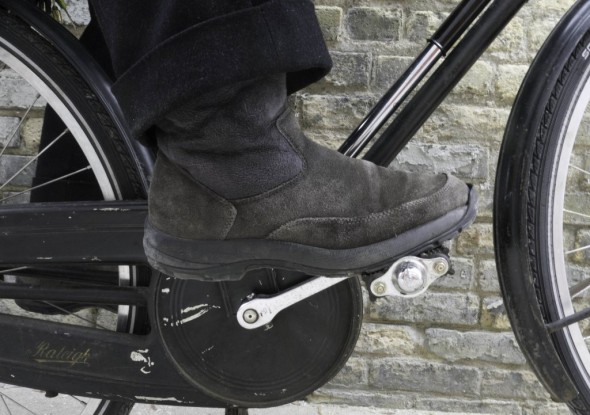
I don’t like to change shoes at work, so I make these gray LL Bean insulated boots work with black wool dress slacks.
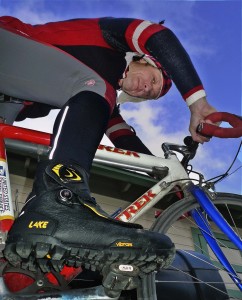
Lakes are great winter boots, but they are a bit to geeky for me to wear around the office
Boots: Like most people in Wisconsin, I have a wide assortment of different winter boots, from lightweight dress boots and shoes all the way up to Sorels. I tend to treat my leather boots with beeswax based Brooks Proofhide or Sno Seal to waterproof them. I just wear thick wool socks to keep my toes warm. On the coldest days, I have a pair of LL Bean side-zip insulated boots that I can pair with dress slacks and get away with wearing in the office all day.
My commuter bikes all have platform pedals, so I don’t have to worry about winter clipless footwear on my ride to work, but if you do ride clipless to work, I highly recommend the Lake MXZ 302 winter mountain bike boots. I wear my Lakes for long winter and early spring training rides as well as mountain bike and Schlick Northpaw rides. I had an older pair of Lake winter mtb shoes that I did not like as much. These are pretty great from a warmth and waterproof standpoint. For a full review of them check out this blog post here.
The 45NRTH Wölvhammer boots are new kid on the winter clipless footwear block. At about $365 a pair, they are out of my price range. If you have a pair, let us know how you like them in the comments below.
This story was originally published by the Bicycle Federation of Wisconsin.
Bike Czar
-
Join a Bike Ride Under the Polish Moon
 Jun 1st, 2018 by Dave Schlabowske
Jun 1st, 2018 by Dave Schlabowske
-
9 Reasons to Join National Bike Challenge
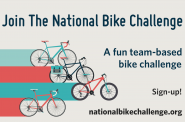 May 4th, 2018 by Dave Schlabowske
May 4th, 2018 by Dave Schlabowske
-
Biking Through the Mindoro Cut
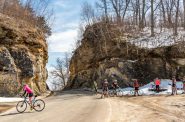 Apr 27th, 2018 by Dave Schlabowske
Apr 27th, 2018 by Dave Schlabowske

















Layers. I find not having a car gives me a comfortable budget for a comfortable ride. This year I began using Merino (from Icebreaker) long johns, and it is really what their ads say it is. Breathable and warm, both. I tend to overdress at the start of the cold season and thereby re-learn what I really don’t need at certain wind and temperature levels. I have counted seven mostly-thin layers sometimes (winter coat is 2). Last year I used the Goretex a lot more, but so much of the cold weather has been below 20 this year, so it’s waiting its turn, for spring and, of course, for rain.
My feet don’t get cold. Hiking boots and one layer of cotton socks do it for me. I do have a winter “bottom” – 15degrees and no wind – below that and/or wind I’m on the bus.
If I’m overdressed, I have learned to slow down a bit at the first sign of dampness.
I like the idea of goggles, but is there a side-vision issue? And I would still need to wear my prescription “distance” glass.